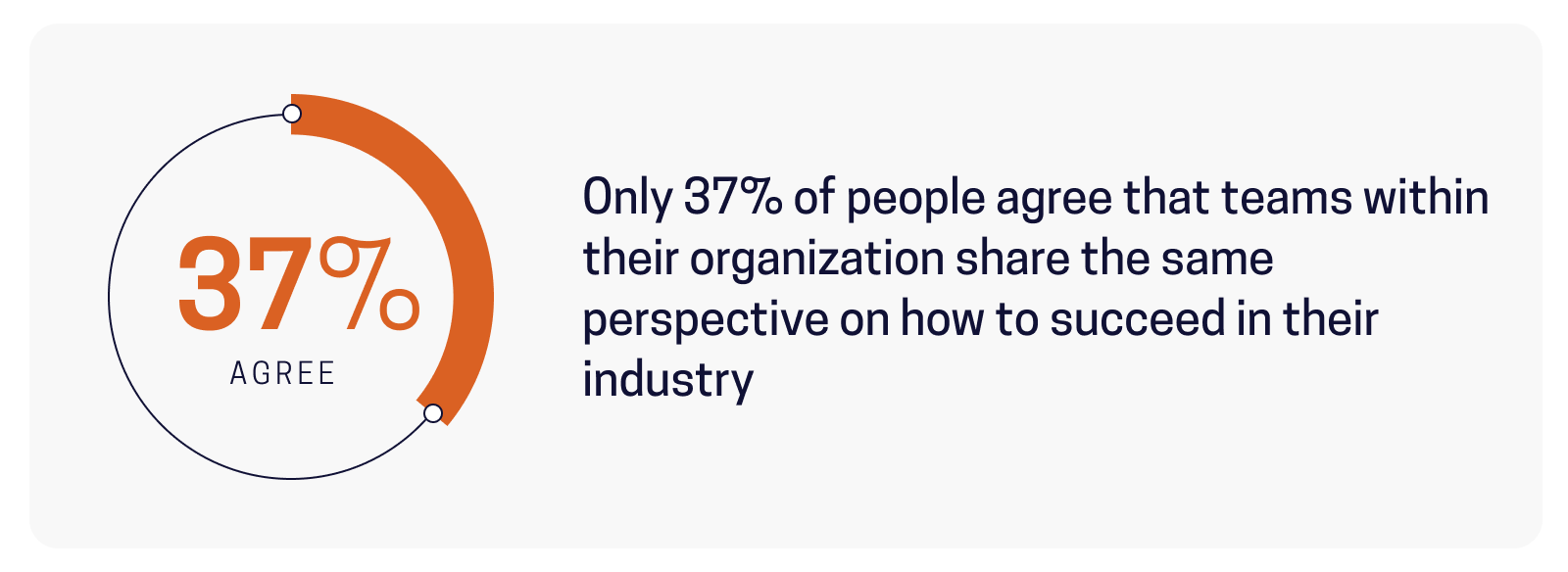This page answers the question "what is strategy alignment" and the various components. For more up-to-date content and a comprehensive overview of strategy alignment, please visit our Strategy and Execution capability page.
Leaders of agile and resilient teams and organizations invest in strategy alignment. They know it's vital to building and nurturing an effective team.
Not only does strategic alignment enable decision-making and the ability to execute strategy, it instills a common purpose. This motivates and unifies an organization.
In this guide, we'll explore what strategic alignment is, why it's important, and outline a proven strategy alignment model you can use to start building strategically-aligned teams today.
What is Strategic Alignment?
Strategic alignment is the act of aligning a team's function with the purpose, and the intent leaders have for it. Also called strategy alignment, the goal is to enhance each team's performance to meet broader organizational objectives more consistently.
You have two basic types of strategic alignment.
1. Bottom-up Alignment
A front-line manager looks at the organizational goals that have been communicated to them by senior leadership. Then they evaluate their role and responsibilities within the organization related to that goal.
From this, the manager establishes the priorities and tasks they should work on. These should contribute to meeting those goals.
Of course, the manager could stop there—getting to work on that list of priorities. But that's not ideal.
Within this scenario, the best thing the manager could do is take their ranked list of priorities to their boss and say, “These are my current priorities ranked in order of importance. Does this ranking need to change? Are there any priorities I need to add? Are there any I need to drop or delegate to others?”
We don't have to tell you that bottom-up alignment is not ideal. Experienced managers should do this when leadership is not clearly establishing the priorities.
But not all will.
Is this the current state of business within your company? Not only are you relying on every front-line manager to "know" that you expect this, you’re also wasting time and resources.
Because you’re not working in synergy .
2. Top-down Alignment
A strategic leader communicates what the priorities are. They detail why this is the priority.
It's critical for the front line to understand how a priority fits into the big picture because this drives more effective decision-making related to that priority.
Now, down to the front line, they know what's important and can color in what they need to do with their teams to meet that priority.
This front-line manager can confidently act without continually checking back with their boss. They have enough information to make informed decisions and do their best work.
Moreover, they have enough big-picture insight to cooperate across teams and departments.
As long as they are working toward the priority, they move toward the North Star pointed out by C-suite leadership. As an organization, this is where you want to be.
The Importance of Strategy Alignment
Leaders who achieve strategic alignment can reliably predict the outcomes of initiatives within their organization. They trust that people make results-focused decisions at every level to achieve goals.
A straight line you've drawn between effective strategy and execution makes this possible.
Everyone within the organization can feel this shared sense of purpose. They know why they're here. At the same time, leaders feel confident they can effectively allocate and invest the resources that teams need to execute the unified strategy.
But this doesn't happen on its own. And quite frankly, it isn't happening in many organizations as a recent large-scale survey showed.
C-Suites Aware of Lack of Strategy Alignment
That's a telling survey result, but it gets worse! Break down who agreed, and you find that only 29% of strategic leaders felt this way, dragging the average down. Front-line employees were more confident that teams shared success definitions at 41%.
In other words, the leaders were very aware that the teams in their organizations were working in different directions. They're the ones who should be responsible for defining "success" for the organization.
Many Leaders Fail to Understand What's at Stake
Employees who say they understand how what they do contributes to broader company goals are 3X more likely to be highly engaged. Let's put that engagement into perspective.
The 2022 Microsoft Work Trend Index Special Report found that priorities-focused employees are 4X as likely to stay with the company for at least 2 years and 7X less likely to seek other job opportunities. They're 4.5X more likely to say they're "happy working here".
On average, companies with highly engaged employees experience 23% greater profitability. When everyone's working toward the same company goals with shared strategic priorities and definitions of success, that impacts the bottom line.
Engagement Has Never Been More Critical to Business Success
Within the poorly aligned organization, it's easy for unengaged, underperforming employees to skate while you continue to pay their salaries. This drags the whole company down.
In the days of human resources trends like Quiet Quitting, Bare Minimum Monday, Quiet Firing, Great Resignation, and Mass Layoffs, ensuring our employees stay engaged at all levels has never been more critical of the organization.
And this isn't an individual contributor problem. The engagement that empowers effective teams starts from the top—as the next survey response shows.
Employees Want to Feel Engaged in the Big Picture
Only 53% of employees surveyed said they know how their team goals contribute to the big company goals. Yet, at the same time, two-thirds say they understand how their performance meets their team goals.
This indicates some alignment at the bottom that doesn't go all the way up. As a result, it doesn't impact the business goals you'd hoped.
This tells us that front-line tactical managers and individual contributors are trying to align. However, in many cases, leadership isn't providing the strategic direction they should align with. There's an apparent breakdown in understanding strategic vs. tactical alignment.
Because of this, strategic initiatives aren't translating to tactical execution.

Strategy Vs. Tactical Alignment
The strategic plan outlines your long-term goals and how you'll reach them. It provides you with a clear path to follow to achieve your company's mission. Strategy is developed at the top, in C-suite.
Tactics are the more tangible short-term steps people follow to meet goals. These include best practices, resources, and operations. We're executing the strategy.
Tactics are what's happening on the ground. They may change— slightly or drastically—quarter to quarter or year to year as you adapt to stay on the strategic path.
You CAN have tactical alignment without a strategy. But those tactics aren't moving you down a path toward achieving your mission.
All teams need a North Star to move forward together—or they continue to do their own thing.
Operating Rhythm Links Strategy to Tactical Execution
52% of those surveyed agree that leadership communicates the priorities when they're expected to execute multiple projects. In comparison, 53% say that their organization regularly communicates where the company stands regarding meeting objectives.
This demonstrates that nearly half feel there is a disconnect between what's happening at the top (strategy) and what's happening on the ground (tactical execution).
So, it's no wonder that only 40% believe that company resources are allocated fairly to enable them to reach their goals.
Taking a closer look, we see that within organizations that frequently communicate the status of organizational goals, employees are 8X more likely to believe that resources are being distributed fairly.
These companies where resources are being adequately distributed have established effective operating rhythms among the layers of the organization. They've bridged the gap between strategy and execution.
3 Layers of an Organization
- Strategic Layer is where longer-term decision-making takes place. At this level, data is analyzed, committees are formed, and the company's direction is recalibrated so that the ship continues to move toward its destination.
- The strategic layer is thinking in quarterlies, year-to-year, and five-year plans. That's their rhythm.
- Operational Layer is where middle management allocates resources and keeps teams running. They're the "middleman" in the line of communication between tactical and strategic layers.
- The operational layer is essential because it translates longer-term thinking into what happens month to month. They measure, analyze, and optimize to improve tactical performance based on established goals.
- Tactical Layer is where front-line contributors see what's happening on the ground. Tactical contributors interact in real-time. They work within the environment established by the decisions made at the strategic and operational levels.
- The tactical layer works in real-time, making decisions on the fly. They develop workarounds to get through their day and serve the customers. Each of these split-second decisions and "unauthorized processes" impacts the company.
Each Layer Moves At Its Own Pace
They may all be moving at different paces. But with strategy alignment, they're moving in the same direction. However, in a traditional model, this can lead to an inability to adapt to the changing environment.
Each layer is on a different information cycle. The operational layer translates up the layers and down. There is a delay in the data and insight flow in both directions.
As a result, front-line employees get delayed feedback on how the organization is progressing toward the goal. At the same time, the strategic layer loses touch with what's happening on the ground.
This leads to a lack of strategic agility. But even more, concerning is the perception among tactical layer employees that the strategic layer (executive team) is oblivious.
However, this setup does serve a purpose. Over the long term, this traditional and proven setup increases the structural integrity of the organization.
An effective structure keeps doing what's working. But it also establishes a new operating rhythm that can run simultaneously. This one opens communication channels between tactical and strategic employees when it matters most.
This more effective operating rhythm can transform an organization in so many ways:
- Reinforcing strategic intent and priorities
- Connecting and synchronizing cross-functional teams
- Enabling the sharing of information, context, best practices, and organizational learning
- Fostering ecosystem thinking and a team-based organizational culture of winning together and working toward a common goal
- Promoting organizational focus, drives accountability for the delivery of meaningful business performance
- Surfacing issues and opportunities, enables timely and effective decisions
- Helping organizations anticipate and adapt to operating environment changes
Benefits of Strategy Alignment
From a leadership perspective, aligning teams strategically:
- Draws a straight line between strategy and execution. You're turning what can be a hypothetical and intangible "strategy", into actual results.
- Ensures clarity of purpose among team leaders. This enables effective decision-making and eliminates siloes by promoting cooperation across teams and departments.
- Generates a common purpose that motivates team members to do their part. Team members know what you expect of them and how to do it.
Everyone is working in the same strategic direction, driving toward what you've communicated as the company's “North Star.”
Regardless of job function or role, each contributor:
- Understands your company's priorities
- Knows where you stand on meeting organizational goals
- Recognizes how what they do every day directly contributes to the meeting of those broader business goals

The Consequences of Strategic Misalignment
Each front-line manager will create their own without shared goals, priorities, and definitions. These may—or may not—help the organization reach its goals.
Most often not.
They may even be in direct competition with other departments. This leads to resource tugs-of-war and difficulty in strategic execution.
All in all, these teams are working harder than they have to with less to show for those efforts. Silos prevent effective collaboration. Division occurs.
Management throws their hands up. Employees disengage and eventually quit—literally or figuratively.
Strategy Alignment Vs. Organizational Alignment: What's the Difference?
Organizational alignment is the act of making sure everyone within the organization is working from the same playbook. With strategy alignment, you're writing the playbook that unifies teams in purpose. Strategy alignment must exist first.
That leads us to the McChrystal Group's Strategic Alignment Model.
McChrystal Group's Strategic Alignment Model
What is a strategic alignment model? It's a thorough look at all the relevant components of developing a business strategy. Alignment is all about getting these components working in unison in one direction—across the enterprise.
What are the Components of Strategic Alignment?
- Vision/Mission Statement. Your vision or mission is your "why?". It defines your direction, aspirations, and passion for where you're going as a company.
- Values. This is how you expect people within your organization to act. Values are broken down into two areas:
- How the organization behaves. For example, do we win at all costs or win together?
- How we invest resources. Where do you spend time, money, and mental effort? If you want more of something, you place your focus there.
- Objectives.What are you trying to accomplish? Remember to make objectives quantifiable, measurable, and time-bound. Different goals may exist for shareholders, customers, and employees. But they work in unison to accomplish the mission.
- Strategy. How are you going to get this done? Your overall strategy will describe your method or approach. It lays out where you'll take risks and when you'll play it safe.
- Initiatives. Where will you allocate resources based on your priorities?
- Focus on the critical few. Don't be distracted by urgent non-priorities.
- Describe actions, outcomes, and expectations.
- Designate supporting and supported relationships.
Examples of Strategy Alignment in Action: How Intuit Applied this Model to Escape Siloed Thinking
Intuit is a successful and long-established global financial tech company. You probably may use, or have used, their products professionally and personally.
That's because they have 3 distinct lines of business.
- Individual/Personal: CreditKarma, Mint, TurboTax, etc.
- Small businesses: Quickbooks products, MailChimp, etc.
- Financial professionals: ProSeries, LaCerte Tax, etc.
For decades Intuit added to its product lines and siloed these three distinct lines of business. But this forgets one crucial point.
The individual may also be a small business owner or accountant. A small business grows into a larger business, eventually moving from silo 2 to silo 3.
There is overlap in who needs these tools. And that need may be a progression. Yet, as siloed tools, they were not sharing the components of strategic alignment.
As a result, each one saw one type of audience without recognizing the overlap and progression—to the point that a B2B or B2C customer didn't even realize all these tools come from the same company.
Because of this lack of realization, customers wouldn't naturally progress, upgrade, and add products.
Intuit was not leveraging the trust it built with customers in each vertical to upsell and expand. This allowed competitors to "steal" customers already using Intuit's other products.
This model worked for a while. But the weakness of these non-aligned verticals became more apparent as tech companies moved to a Software as a Service (SaaS) model.
Within the SaaS model, people expect a suite of tools they can access all in one place. They expect to be able to add from that suite as needed.
Intuit needed to unify its three verticals from the top down. To accomplish this, we helped them progress through a series of stages:
1. Unify the Message
The company needed to define what it would mean to become one company to all customers. That message had to come from the top, and each line must be able to communicate it.
2. Establish a Communication Cadence
Because of the siloed nature of the business structure, we needed to open up the communication not only between each vertical and the strategic leader (C-suite). We had to establish communication between leaders across the three verticals.
3. Drive Value Across the Whole Customer Base
With cross-vertical communication established, each silo thinks not only about its product line. They're thinking of the company as a whole.
How does this new product we want to launch integrate and overlap with the others? How can we use that overlap to sell customers the idea of expanding their suite of tools?
4. Increase the Value of The Brand
By unifying the siloes to deliver the greatest value to customers, Intuit increased the value of its brand in the eyes of financial experts, shareholders, employees, and customers alike.
5. Lead by Example
In a short time, the company has become an example of achieving strategy alignment even as a massive, global company. They regularly invite others to see how their once-misaligned units work together.
View case studies to see how other companies addressed misalignment to transform into more effective and agile companies.
How to Achieve Strategic Alignment
McChrystal Group helps organizations follow these 5 steps for strategy alignment:
- Clarify your organization's purpose and identify your core values: Help everyone know what they're working for. But it also tells them how—and how not—to go about it.
- Develop a shared vision: Identify strategic priorities and align the entire organization around them.
- Identify key performance indicators: How will you measure progress toward strategic goals? This ensures that everyone is working towards the same objectives and that progress can be tracked and measured. You'll establish team efficiency metrics to measure performance on a team and intra-team level.
- Develop a communication plan: Ensure everyone in the organization is informed and aligned around the strategy. This includes regular updates, feedback loops, and engagement activities. Those feedback loops must bypass the traditional rhythm of the 3-layered organization to ensure strategy and tactical maintain open lines needed for agility leadership.
Overall, McChrystal Group helps organizations align their strategic initiatives by ensuring that everyone in the organization understands and is working towards the same objectives, KPIs, and priorities.
They also help create a culture of collaboration and teamwork that supports strategy execution.
How Strategically Aligned is Your Organization?
There is no one-size fits all, as this depends on your mission. So, start there. Then consider your True North Goals.
When we were in the process of evaluating and helping Intuit complete strategic alignment, they established these goals:
- Employees: Create an environment where the world's top talent can do their best work.
- Customers: Delight customers more than the competition when it matters most.
- Shareholders: Inspire confidence in our long-term growth, leading to a higher stock price
Now, with your own goals in mind, ask yourself these two all-important questions.
- Did your business strategy help you reach these goals?
- Does your organization have the infrastructure to execute the strategy?
If your answer is "no" to one or both of these, it's time to evaluate your organizational strategy and execution to improve team effectiveness.
Deploy the McChrystal Group's Strategy Alignment Model
It's evident that your company isn't as aligned as it could be. Communication is delayed, and teams are not working effectively together.
As a result, strategy isn't translating into tactical execution, and you're not meeting your enterprise's purpose.
As the competitive environment around your business continues to heat up, it will only become more challenging to continue with a misaligned structure.
It's time to drive the results that matter. Organizations perform when teams work. Schedule a call to unlock their true power.



